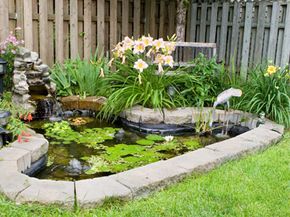Pond Building Instructions
With the square spade, undercut and remove sod from the interior of your outline, then switch to the rounded shovel and start digging.
For a pre-formed liner, you'll need to dig to fit its depth contours. For each type of liner, start digging where the pond will be deepest and work to the edges. Vary the depth of flexible liner ponds to enhance fish viewing and create ledges around the perimeter for plants, stones and safety. The perimeter ledge should be 3 to 6 inches (7.5 to 15 centimeters) below the pond edge and 6 to 12 inches (15 to 30 centimeters) wide, dropping straight down like a step to the next level [source: Better Homes and Gardens]. If you plan to build a raised waterfall or streambed, move the excavated dirt to that spot.
Advertisement
Apply a .5 to 1 inch (1.3 to 2.5 centimeter) layer of sand, or underlayment, on all levels of the pond and rake it smooth. This will help to prevent punctures and tears in the liner from rocks and roots that may rise up under the pond after installation. Next, cover every surface of the hole with underlayment, bending and pleating it to fit. The underlayment should extend over the pond edge and far enough around so that it stays in place when you put the liner over it. Then, you'll place your liner in the hole. The pond liner extends over the pond edge by about 2 feet (0.6 meters). You'll trim excess liner after laying your edging material. If you want your pond edging to be level with the pond, you'll need to dig a rim around the outside of your perimeter wide and deep enough to seat your edging material. Slightly lowering the ground bordering your pond will also allow rain and irrigation water to drain away from it.
Leveling your pond edge is critical. If one side is lower than another, the pond will look lopsided, water will escape from the low side and the liner will show on the high side. To see if the edges are level, place a long, straight board across the pond and center the level on it. Check for level around all sides of the pond and raise or lower the edges as necessary. The entire excavation must be level for pre-formed ponds. Otherwise, the form will sag, twist and crack.
In the next section, we'll discuss the electric component of your pond, and then we'll finally get it filled and ready to go.
